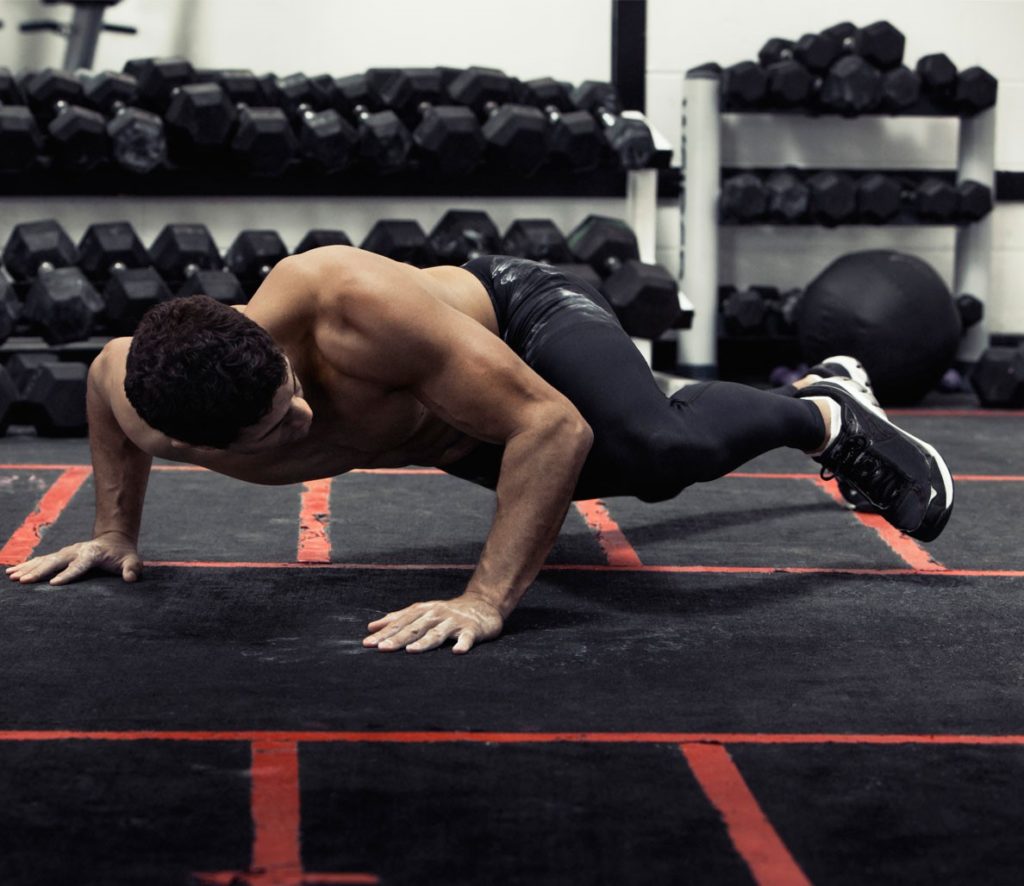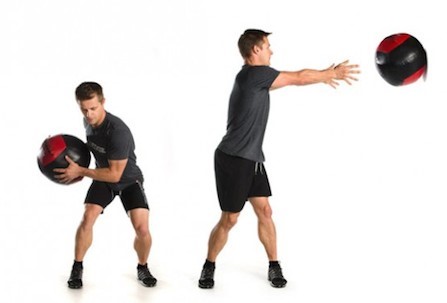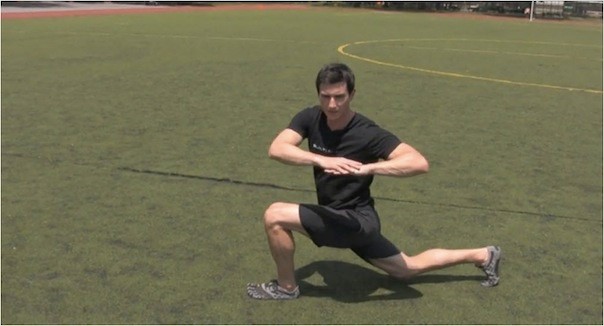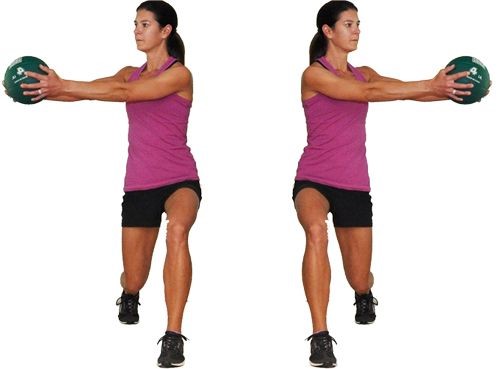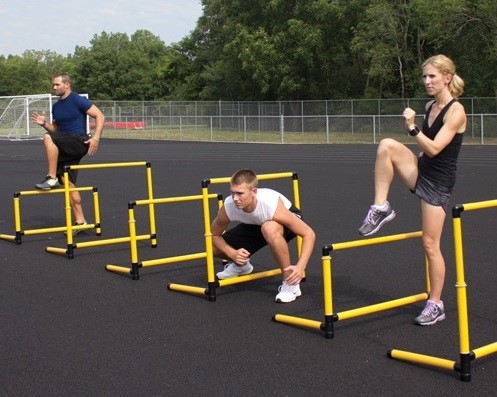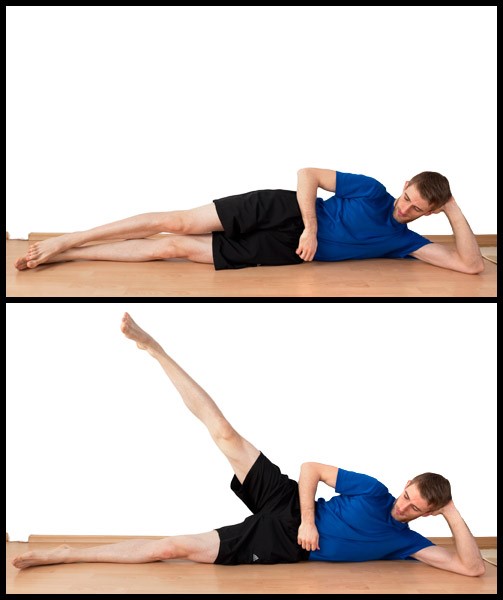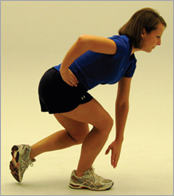Core Strength and Flexibility
by Peter A. Wright
Lower back pain is no fun. It’s like jamming an extra book into your bag that’s constantly pressing against your spine. Eventually, it finds a nerve and consistently pushes against it. The pain can sideline you during a meet, or it can last long after you’re done racing. Fortunately, your core muscles and your flexibility can provide crucial support for your lower back.
[am4show not_have=’g5;’]
[/am4show][am4guest]
[/am4guest][am4show have=’g5;’]
Injuries can strike at any time. Coach McGill addresses this issue in his article Hurdler Injuries in which he states that the measures runners take to prevent injuries are “best-case scenario.” You strive to reduce the risks: you wear layers when you warm up and you stretch your hamstrings, lower back, groin, hip flexors, and calves before and after practice [i] but despite your best efforts stuff happens and you pull a hamstring. It’s okay. You get past it, and you’re back on the track in a few days.
But what if it doesn’t? What if that book finds a way into your imaginary backpack? How can you prepare your body to minimize the risks to your lower back? First of all, listen to your coach. He or she has the experience to guide you toward success. But on your own, you can perform exercises to strengthen your core and increase your flexibility to take the pressure off your lower back. That way, hopefully, you can practice and compete as long as you enjoy hurdling and, if you ever hang up your cleats, you’ll be pain-free.
Coach Richard Holmes (Holmes Hurdle Tech) has worked and trained with the best. He’s gained, studied, and examined hurdling knowledge from Olympic medalists as well as national, college, and high school champions. Coach Holmes is a USA Track and Field Registry-Approved Coach and twice was the USATF US Masters 110HH Champion. He advises that hurdlers focus on their core muscles to prevent injury. He says that “if the abdominals (lower and upper) are sound and strong, this will assist in taking the pressure off the lower back to avoid injuries.” In an email, he continued: “…as we have learned over the years, lower back pain can be connected with weak hips, abs, glutes, and abductors… All of these issues should be addressed.”
So, let’s address them.
Lower and upper abdominal work exercises strengthen your core muscles and provide support for your lower back by making you less prone to back injuries and teaching you proper spinal alignment. [ii] Statistics show that up to eighty percent of adults have experienced lower back pain at some time in their life. [iii] As many as fifty percent of teenagers suffer from back pain by the time they’re eighteen to twenty years old. [iv] This back pain is serious stuff. If you want an idea what it’s like to suffer from it long-term, re-read the first sentence of this article.
Lower back pain may be a result of weak abdominal muscles. Your abs anchor the front of your spine. If they’re weak, then your back muscles will have to work harder. By strengthening your core, you’re less likely to sustain an injury to your back muscles.” [v]
The following are three exercises designed to strengthen your upper and lower abdominal muscles.
Spiderman Plank
Photo: Men’s Health
The Spiderman Plank works your entire core: the front and back of your abdominal area simultaneously without zero equipment. Also included are your obliques, your lower back (score!) and your rectus abdominis. It’s, simple, effective and you can do it anywhere. [vi]
Photo: Leanitup.com
Medicine ball side throws quickly ignite the core, especially the obliques. The throws build the torso’s rotational power, and contribute to your core’s overall strength. You’ll want to concentrate and throw the ball as fast and with as much explosive energy as you can. This will ignite your core, legs, and arms in a way that a lot of other exercises don’t.
You’ll want to do these with a friend or against a wall. If you have a partner, give yourself lots of space and/or increase the weight to up the difficulty. You want to try to knock them down with your strength and power. Careful, though, you have to pay attention because they’re trying to do the same thing! [vii]
Medicine Ball Sit Up and Throw
Photo: https://manbicep.com/2013/07/17/10-partner-exercises/
The medicine ball sit up and throw affects the abs, arms, and chest. You’ll build massive core strength on the way up – which can develop your six-pack just in time for summer – and, since you employ your upper body for the finish, really puts muscle on.
Since you’re chucking the ball from an unbalanced position on the floor, you’re adding an additional element of core strength to finish the exercise. Like the medicine ball side throws, these work better with a buddy. They can start out at your toes and back up after every few throws to increase the difficulty and strength. If you’ve intimidated your friends, you can use a wall instead. [viii]
Limited flexibility can cause problems as well. “…if the flexibility is not there with the most basic of static stretches, that is also an indicator that lower back pain could be an issue.” Coach Holmes has his athletes warm up for practice with dynamic exercises and advises them to perform static stretches away from the track, at home in front of the TV or the computer.
Dynamic stretching “is active stretching during controlled movements.” The stretches increase blood flow, expand your range of motion, help you become more aware of your joint position, and increase your athletic abilities. You want to do these stretches slowly but with continuous movement so that your heart rate rises while you warm up your muscles. Everyone from amateur athletes to the pros in the NFL and NBA are doing dynamic stretches. [ix] And if your competition is doing it, you might want to consider doing it, too.
Single-Leg Over
The Leg Institute
The single-leg over, or Supine Leg Swings because you perform them lying on your back, helps you by stretching your hamstrings, glutes, lower back, core, and chest.
These are valuable for your lower back and your explosiveness off the line. [x]
Lunge With A Twist
The lunge with a twist is a combination of the forward lunge and the horizontal twist of your torso. The lunge flexes the hip flexors and activates the legs, glutes, and hips while the twist elongates the middle and upper back and engages core rotation. [xi]
Photo: BuiltLean
You can also expand the exercise by incorporating a medicine ball. By rotating the ball slowly from side to side, you’re activating the stabilizer muscles in your legs and hips. [xii]
Paige Waehner
Over and Under Drills
theironcompany.com
While “the lateral over/under promotes overall hip flexibility and prepares your body for a demanding workout.” [xiii] The exercise also strengthens your core and improves coordination. [xiv]
Another area you want to concentrate on are your hip abductors and adductors. Your abductor muscles include the gluteus maximas and gluteus medias muscles. [xv] You use these muscles when you kick your trail leg out to the side. Your adductor muscles pull your leg back in after you clear the hurdle. [xvi]
The gluteus maximus is one of the strongest muscles in the body. The muscle is responsible for extending the thigh, helping you to walk, run, lift your trail leg and it enables you to stand up. [xvii]
It also contributes to running speed and is mostly used when force is needed instead of when you’re walking. [xviii]
The gluteus medius is positioned beneath the gluteus maximus and, along with the gluteus minimus, abducts (or lifts) the thigh at the hips and rotates it laterally while stabilizing your body when you only have one foot on the ground, such as when you’re running or hurdling. [xix]
With glute work we slide into static stretching…
While dynamic stretching may be more appropriate as part of warming up, static stretching is designed to increase range of motion. [xx]
Also, unlike dynamic stretching where the goal is to slowly move through the exercise without stopping, static stretching’s best results are obtained by holding each stretch for 10 – 30 seconds, listen to your coach’s recommendation. Other guidelines to follow would be to be warmed up before you stretch. You want to stretch the muscle to just before the point of discomfort and allow the tightness in your muscle to ease off as you hold it. Always breath into the stretch. Don’t hold your breath. Stop if you feel pain. Shake out the limb between stretches and complete 2 – 3 reps before moving on. [xxi]
Side-lying abduction
This exercise primarily affects your glutes as well as your obliques, abdominals, and outer thighs. [xxii]
Standing Leg Abduction
http://clipartnew.com/band+abduction+and+adduction
This exercise strengthens your abduction, outer thigh, muscles. [xxiii]
Standing Leg Adduction
http://clipartnew.com/band+abduction+and+adduction
This exercise strengthens your adduction, inner thigh, muscles. [xiv]
Single-limb squat
https://mikereinold.com/best-exercises-for-gluteus-maximus-and/
Another good exercise for the gluteus maximas. [xxv]
Single-limb deadlift
www.bodybuilding.com
This exercise works both the hamstrings [xxvi] and incorporates an “active hip extension and flexion on a single-leg stance, just like running, kicking, and many other actions.” [xxvii]
These exercises are a good beginning to strengthening your core muscles and improving your flexibility and, hopefully, decreasing your times on the track while reducing your exposure to potential injury.
There is good news.
Coach Lee Pantas (Great Hurdlers) is a hurdles and sprints coach for A.C. Reynolds High School in Asheville, NC and the Assistant Head Coach for the Asheville Lightning Junior Olympics Team. He’s a USATF Level 1 coach and has coached hurdles since 1996. He’s only seen a few instances of athletes with lower back pain because, he believes, of a program he designed that focuses on “the core work (crunches, arm rhythm drills [xxviii], weight training) over time help to prevent back issues.”
So both Coach Holmes and Coach Pantas stress the importance of strengthening your core muscles and flexibility to prevent back injuries. Coach Pantas also adds that these “two concepts relate to any other track and field event.”
Believe me, you want to protect your lower back. You don’t want to be walking around in pain for the rest of your life.
What if everything goes well and you want to compete at the Masters level? How do older hurdlers prevent injuries since they’re so… old and frail and stuff? Good question.
Nick Vaglio is 66 and he weighs 190. He started hurdling in his fifties and last indoor season, he ran a 9.34 automatic time in the 60 meter hurdles when the Masters All-American time for that event in his age group is more than a second slower at 10.6.
I asked him how he maintains his flexibility. You already know the answer. “Core strength is the most important as well as resistance training.” When asked about injuries, he related one story about in injury that kept him out of an event. He was working outside in 38-degree weather and strained his hamstring because he never loosened up. “If there is some advice I would give that would be to not skip the muscle groups in your warm ups. One time I forgot to do the calf exercises and of course I got a tweak in that muscle early on and had to stop.”
Concentrate on your core, do your stretches to maintain your flexibility, and you’ll take care of yourself, your muscles, and your ability to have fun.
[i] Steve McGill, Hurdling Injuries, 2017, https://hurdlesfirstbeta.com/free-articles/training-tips/hurdler-injuries/
[ii] Graeme Keys, Building Core Strength to Reduce Back Pain, January 13, 2017 https://www.spineuniverse.com/wellness/exercise/building-core-strength-reduce-back-pain
[iii] Office of Communications and Public Liaison, Low Back Pain Fact Sheet, December 2014, https://www.ninds.nih.gov/Disorders/Patient-Caregiver-Education/Fact-Sheets/Low-Back-Pain-Fact-Sheet
[iv] Peter A Nigrovic, MD, Patient education: Back pain in children and adolescents (Beyond the Basics), September 18, 2015, https://www.uptodate.com/contents/ back-pain-in-children-and-adolescents-beyond-the-basics?source=see_link
[v] Keys
[vi] Men’s Fitness Editors, 5 Exercises to work your abs to exhaustion, Men’s Fitness, October 26, 2016 http://www.mensfitness.com/training/build-muscle/5-exercises-to-work-your-abs-to-exhaustion
[vii] Bryan DiSanto, 6 Power Medicine Ball Exercises To Dominate Your Core And Blast Your Body, November 12, 2014, http://www.leanitup.com/6-power-medicine-ball-exercises-dominate-core-blast-body/
[viii] Bryan DiSanto, 6 Power Medicine Ball Exercises To Dominate Your Core And Blast Your Body, November 12, 2014, http://www.leanitup.com/6-power-medicine-ball-exercises-dominate-core-blast-body/2
[ix] Heather Moore, Static vs Dynamic Stretching, January 28, 2014, http://www.
philly.com/philly/blogs/sportsdoc/Static-vs-dynamic-stretching.html
[x] Mike Behnken, The Importance of Stretching the Lower Body and Core
[xi] Marc Perry, Try This Full-Body Dynamic Warm-Up to Prep for Any Workout, August 14, 2013, http://greatist.com/fitness/full-body-dynamic-warm-up
[xii] Paige Waehner, Best Standing Ab Exercises for a Strong and Fit Core, October 6, 2016 https://www.verywell.com/best-standing-ab-exercises-for-a-strong-fit-core-1230735
[xiii] Swinnen/Van Heddegem, Hurdles, http://functionalresistancetraining.com/ exercises/material/hurdles?page=1
[xiv] Swinnen/Van Heddegem, Lateral Walk Over/Under, http://functionalresistancetraining.com/exercises/lateral-walk-over-under
[xv] Dr. Larry Van Such, Anatomy Lesson #7 Hip Abductor Muscles, http://www.athleticquickness.com/hipabductors.asp
[xvi] Dr. Larry Van Such, Anatomy Lesson #4 Hip Adductor Muscles, http://www.athleticquickness.com/hipadductors.asp
[xvii] MusclesUsed.com, Gluteus, http://www.musclesused.com/gluteus/
[xviii] Paul Rogers, Definition of Gluteus Muscles, April 21, 2016, https://www.verywell.com/role-of-gluteus-muscles-3498371
[xix] MusclesUsed.com, Gluteus, http://www.musclesused.com/gluteus/
[xx] Phil Davies, Static Stretching, http://www.sport-fitness-advisor.com/staticpassivestretching.html
[xxi] Phil Davies, Flexibility Exercises, http://www.sport-fitness-advisor.com/flexibility-exercises.html
[xxii] Exercise.com, Lying Hip Adduction, https://www.exercise.com /exercises/lying-hip-abduction
[xxiii] Dr. Larry Van Such, Anatomy Lesson #7
[xiv] Dr. Larry Van Such, Anatomy Lesson #4
[xxv] Mike Reinold, The Best Exercises For The Gluteus Maximus and Gluteus Medius, https://mikereinold.com/best-exercises-for-gluteus-maximus-and/
[xxvi] BodyBuilding.com, Single Leg Deadlift, https://www.bodybuilding.com/ exercises/detail/view/name/single-leg-deadlift
[xxvii] Andrew Reed, Proper Progression And Loading For The Single Leg Deadlift, https://breakingmuscle.com/learn/proper-progression-and-loading-for-the-single-leg-deadlift
[xxviii] Arm Rhythm Drill (or “Ground Hurdling”):
The hurdler sits with one leg extended and the other leg (trail leg) flattened out on the ground as if going over a hurdle. Seated, they then arm run and on every 4th beat lean forward over the lead leg as if hurdling, with the proper arm motion. This also strengthens their core muscle groups.
[/am4show]
